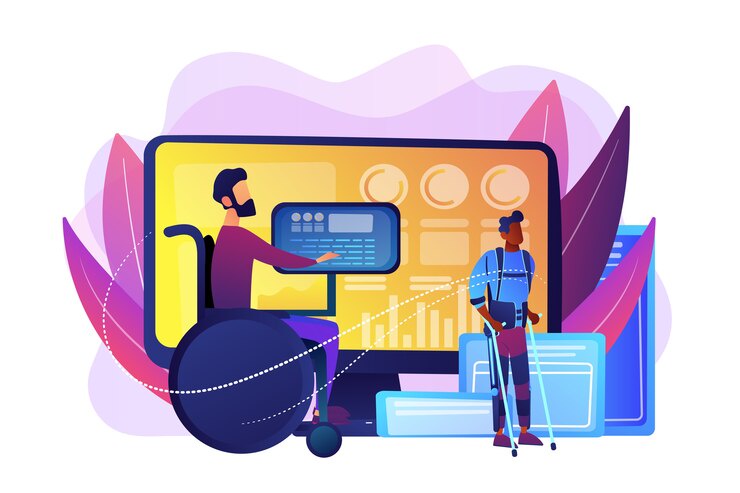An accessible website is an important part of digital inclusion. It ensures that everyone, whatever their physical ability, has access to important information on the internet. This is how you make your account accessible to everyone. Whether you own an e-commerce site or a web development company, you want to get as many people as possible to your website. That means prioritising website accessibility so that as many people as possible can use your site. Website accessibility entails ensuring that your site is usable by everyone, including people with disabilities and impairments. There are numerous resources, tools, and advice available to help you create a more inclusive website.
Why should your website be accessible?
A website should be accessible for the following reasons:
Inclusivity
Being inclusive ensures that users and visitors with all abilities can use and access your website. This encourages the creation of an online community in which all members have access to the same resources and information.
Legal requirements
A variety of national laws and regulations require that websites be accessible to people with limitations. Organisations must make their websites accessible to people with disabilities.
Business
Making your website accessible may benefit your business. You may reach a broader audience and boost consumer happiness by creating an inclusive online environment.
Ethical considerations
Being accessible through your website is the right thing to do. It indicates your respect for diversity and inclusion, as well as your commitment to making your website accessible to all.
How Do You Check Your Site's Web Accessibility?
To assess your website's web accessibility, you can:
- Use accessibility tools such as WAVE, Axe Accessibility, or A11Y Accessibility Checker.
- Use automated testing tools, such as WebAIM's accessibility tools or Google Lighthouse.
- Use assistive technology, such as screen readers, keyboard-only navigation, and speech recognition software, to do manual testing.
- Work with an experienced accessibility specialist to evaluate your website.
- Also Read: 10 Simple Steps to Improve Accessibility on Your Website
Strategies for Making Websites Accessible to Everyone
Understand the guidelines and standards.
Before you begin making your website accessible, you need first understand the website standards and accessibility regulations. The most widely used set of principles for creating accessible web content is WCAG 2.1. Although these rules are widely accepted as the norm for digital accessibility, they are not legally binding.
Use Descriptive headings.
To make your website accessible to everyone, use descriptive headings. Headings make your website easier to navigate and understand for users who use screen readers and other assistive technology. To use descriptive headings, just arrange your material using HTML heading elements (H1-H6) in a logical order that reflects the hierarchy of your content.
Colour contrast matters.
Colour contrast is critical for persons who have low vision or are colorblind. To make the text easily readable, ensure that the text and backdrop colours contrast sharply.
The WCAG mandates a minimum contrast ratio of 4.5:1 for ordinary text and 3:1 for large text.
Use Alt text for images.
To make your website accessible to all people, utilise alt text for photographs. Screen readers and other assistive technologies can read an image's alt text, which contains a brief description of the image. It makes it easier for those with visual impairments to understand an image's content and location on a webpage. To utilise alt text for images, just provide descriptive text into the "alt" element of the HTML image tag. Alt text should be succinct and accurate, conveying the image's vital information. In brief, adding alt text to photos is a simple but effective technique to increase your website's digital accessibility.
Include captions and transcripts for multimedia.
Add subtitles and multimedia transcripts to boost your website's WCAG compliance. Transcripts are written copies of video or audio content, whereas captions are text explanations of the same. Adding captions and transcripts to multimedia content allows those with hearing impairments to better grasp the content and context of the medium. To give captions, include a text track in your video or audio file. To give transcripts, generate a text document containing a written rendition of the audio content. Captions and transcripts must be accurate, full, and linked with the media.
Use ARIA roles and attributes.
ARIA (Accessible Rich Internet Applications) is a set of attributes that can be applied to HTML components to improve accessibility. Use ARIA responsibilities and characteristics to provide more information to screen readers and other assistive technology.
Make forms accessible.
Forms are an important component of many websites, but they can be challenging to use for people with impairments. Make your forms accessible by labelling each input field, utilising ARIA characteristics, and ensuring that error messages are clear and easy to read.
Provide clear navigation.
Clear navigation is essential for all users, including those with disabilities. Make sure users can easily find what they're looking for on your website, and that the navigation is easy to use. Make sure your website's navigation is consistent by using clear and descriptive link and button labels.
Test Your Website's Accessibility
It is important to check your website's accessibility to guarantee that everyone can use it. The WAVE Online Accessibility Assessment Tool and the A11Y Accessibility Checker are only two of the many tools available to determine whether your website complies with the WCAG.
Making your website user-friendly for everyone is an important first step towards building a more diverse online community. These tips will assist you in making your website more accessible and inclusive, while also ensuring that no users with disabilities or impairments are excluded. Your website can be made more accessible to everyone in a variety of ways, including using informative headings, providing captions and transcripts for multimedia, and ensuring keyboard navigation. These were some of the best ways to make your website accessible to everyone!


No comments yet